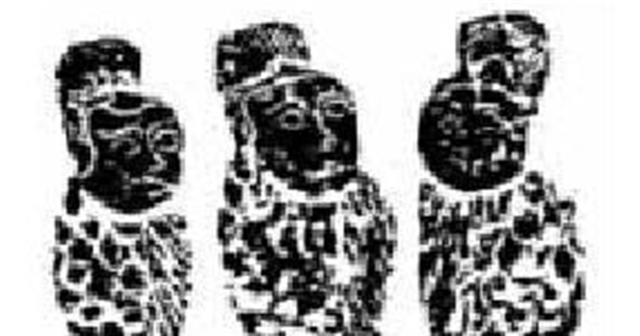Since the 1960s, Shandong has unearthed a large number of portrait stones from the Han Dynasty period; the scenes in the paintings truly and vividly reflect the various social life of people at that time, bringing very valuable archaeological materials to future generations, and making a very powerful supplement to the written records in the history books; some people have found that there is a person spitting fire on a portrait stone, and there are three swords flying on the top of someone's head; is this a mythical image? Experts explain that they are performing the acrobatic art of the Han Dynasty; what is going on? Let's take a look!

The large number of dazzling Han Dynasty portrait stones unearthed in Shandong are the most eye-catching of the various acrobatic arts shown in the paintings, and their characters seem to be gods with various powers.
The Han Dynasty was one of the most glorious and proud periods in the history of the development of acrobatics in the mainland; there were acrobatic performances from the court down to the folk, and the acrobatic art in the Qilu area was particularly prominent, known as "Hundred Plays" or "Horn Arrival"; this can be confirmed by the Han portrait stones and other cultural relics excavated from all over Shandong.
The portrait stone unearthed from Jiaxiang Songshan has preserved for us a wonderful scene of spitting fire: only to see a person in the painting holding his head high, and a raging fire erupts from his mouth; this acrobatic has only appeared in TV dramas, is there really such a superb skill in the Han Dynasty more than 2,000 years ago?
Experts consulted historical materials and found that spitting fire was a popular illusion performance in the Han Dynasty; according to the "Later Han Shu Chen Zen Biography", "In the first year of Yongning, the king of Yishan in the southwest, he was able to spit fire, self-dismember, and was easy to cow and horse head." It is also recorded in the Chronicle of the Chronicle of dawan: "The branches are thousands of miles to the west of the Rest,...... National goodness glare. And there is a commentary that says, "The so-called 'glare' is now the art of swallowing knives, spitting fire, breeding melons, planting trees, slaughtering people, and cutting horses." Judging from the historical records, the acrobatic of "spitting fire" does exist, and it has fantasy and magic colors; the audience is not clear about the mystery here.
From the portrait stones unearthed in the Qilu area, it can be seen that there was also a popular acrobatic called "flying sword jumping pill": after throwing the pill and sword in the air, it was undertaken by the hand or other parts of the body, so that the cycle was repeated, and the pill and the sword could not land on the ground; this acrobatic is often seen today, the actor throws three or five balls, taking turns; the thrown object only has a ball without a sword called "jumping pill", the origin is very early; to what extent? Historical records record that during the Eastern Zhou Dynasty, the "jumping pill" had reached a high level, which was called "lane pill" at that time; according to the "Zhuangzi Xu Wu Ghost", "The city south Yibian made pills and the two families were difficult to solve." "
There are swords in the thrown objects, the danger factor is greater, called "flying swords", it is more difficult, but the origin is quite early; according to historical records, the history of flying sword performances can be traced back to the Spring and Autumn Period; for example, the "Liezi Sayings" has a saying: "Song has Lanzi, with the skill of song and Yuan, seven swords and jumps, the five swords are often in the air; Yuan Jun was shocked, and the golden sword was given"; expert analysis, "flying sword jumping pill" should be in "
do
Maru" and "Flying Sword" developed on the basis of the Han Dynasty, which has reached a very high level; the Han and Jin literature mentions flying swords and pills in many places; for example, in the "Anthology of Literature and XijingFu", there is a saying: "The squandering of the jumping pill sword." Li You's "Ping Xing Fu" mentioned: "Flying pills jump swords, boiling wei back to disturb." The "On Balance and Accumulation" said: "The initiative of the pill sword, the fingers do not know." "......
Today, people see the intuitive picture on the Han portrait stone unearthed in Shandong, which makes people marvel; there are both simple jumping pill performances and complex and thrilling flying sword jumping pills; Anqiu Dongjiazhuang Han Tomb out of The Music and Dance Hundred Dramas, of which the flying sword jumping pills displayed are the largest number of thrown objects: in the picture, one person dancing eleven pills and three swords, the sword pills rise and fall, extremely difficult; it can be seen that the Han Dynasty's flying sword jumping pill technology has reached the level of pure fire.
Moreover, experts have noticed that many places in Shandong, such as Zhucheng Qianliangtai, YinanbeiZhai, Jining Yutun Town Chengnan, etc., have unearthed a large number of portrait stones, of which about 60% have flying sword jumping pill acrobatic performance scenes, indicating that this acrobatic is very popular in the Qilu area of the Han Dynasty.
[References: "Anthology of Xijingfu", "Pingxin Fu", "Qilu Archaeology", etc.]